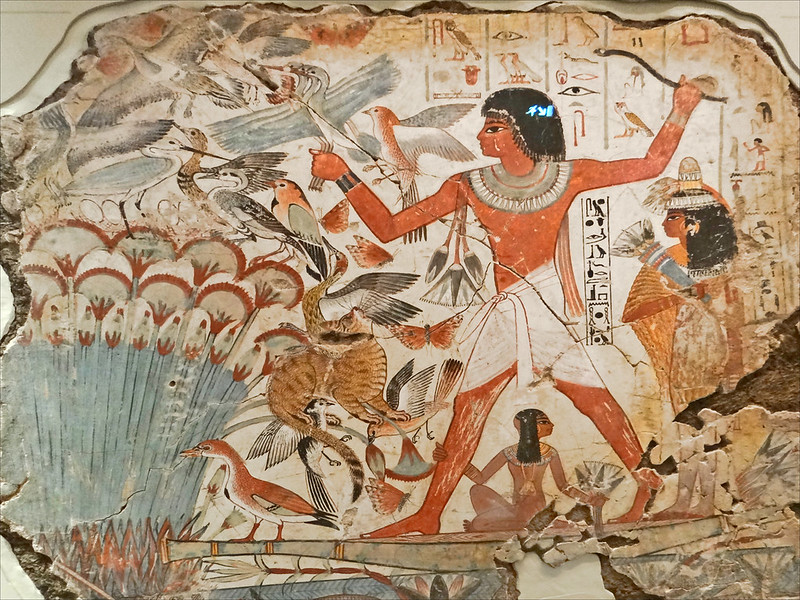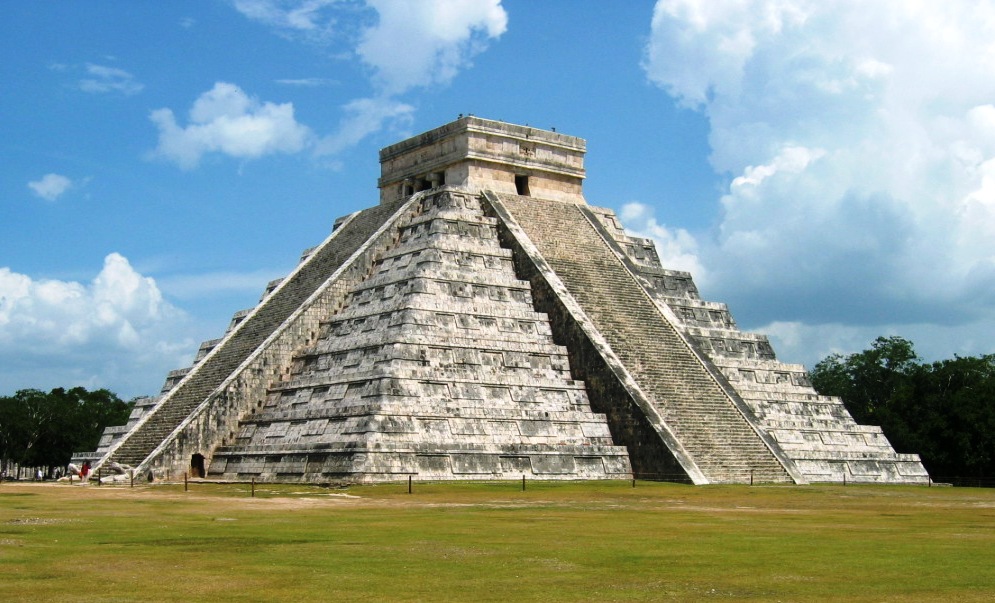Antiquity, considered as the first period in the history of civilisation, follows Prehistory (quite logical, isn’t it?). Indeed, Antiquity begins with the appearance of writing, dated to around 3300 BC. It ends with the decline and fall of the Roman Empire in 476 AD (the beginning of the Middle Ages).
During this period, several great civilisations emerged separately. Thus, civilisations appear in various places on our planet: Africa (Mesopotamia, Egypt), Europe (Rome, Greece), Asia (India, China), America (Mesoamerican, Andean and Circum-Caribbean areas).
Mesopotamian art (present-day Iraq)
The Mesopotamian civilisation developed in the Middle East region. It is considered to be the oldest in human history. It saw the appearance of the first cities and the invention of writing.
Mesopotamian art is mainly characterised by architecture and sculpture in bas-reliefs but also in the round (steles, statuettes, monumental sculptures). There is also engraving linked to the birth of writing and the creation of the cylinder seals that accompanied it. The few paintings represent mainly geometric figures and plant motifs.
The animal theme is the most present, often inspiring the representation of mythological creatures (winged bull with a human head). But anthropomorphic creations are also found, in particular war and hunting scenes.
Clay is the most used material as it is the only one available in abundance in the region.
The Mesopotamian civilisation disappeared around 300 BC with the conquest of the country by Alexander the Great.
Egyptian art
The ancient Egyptian civilisation was built in the Nile region from about 3150 BC until the Roman conquest of Egypt. This led to the end of the reign of the Pharaohs in 30 BC.
Egyptian art is first and foremost characterized by its architecture and in particular by the construction of the monumental pyramids of Giza. But also the construction of temples, including the famous Karnak temple. Several distinct periods succeeded one another during these more than 3000 years. The numerous archaeological excavations carried out in the region have brought to light many treasures: painted ceramics, sculptures (statues, bas-reliefs), paintings (frescoes).
Engraving plays a particularly important role in the writing of hieroglyphs. The discovery of the Rosetta Stone, which allowed their deciphering by Champollion in the 19th century, is of course remembered.
Egyptian art is singularly symbolic and stylised. The representations are first of all those of the gods (monumental statue of Amun, sphinx of Giza), of the pharaohs (funerary mask of Tutankhamun). But one also discovers scenes of everyday life or objects of daily life.
Although sometimes practised as a technique in its own right, painting is mainly used to decorate sculpted works, statues and reliefs. The representations (a source of inspiration for Picasso perhaps?) appear on the same plane, without any effect of depth or perspective.
The colours are spread out in solid colours and the anthropomorphic characters are represented in a very particular way: head in profile but with the eye drawn from the front, the bust from the front and the lower limbs in profile. Finally, their size varies in proportion to their hierarchical level in society, or to their power in the case of gods. 
The artists mainly sculpt stone and wood. The colours for the paintings are obtained from natural mineral products (red ochre, yellow ochre, blue, green, white). Charcoal is used for black. The addition of gum arabic is used as a binder to enable their conservation in the form of cakes for use over time.
The Egyptians also invented a material similar to glass from which they made various utilitarian or decorative objects.
Greek art
Greek civilisation developed from about 800 BC in the Mediterranean basin. The period of ancient Greece ended with the death of Alexander the Great in 323 BC.
Ancient Greek art is represented by architecture, sculpture and painting and is divided into four periods: Archaic, Classical, Hellenistic and Greco-Roman.
Greek architecture is characterised by the creation of walled cities.
The temples dedicated to the worship of the gods are divided into three successive orders (styles) of architecture: Doric (Parthenon in Athens), Ionic (Apollo’s temple in Didymus) and Corinthian (Olympiion or temple of Zeus in Athens). 
In the Archaic period, the earliest, sculptures were mainly made of wood and terracotta. Later, marble and bronze were used to represent mainly anthropomorphic statues (the discobolus) or gods (Venus of Milo). These creations from the classical and Hellenistic periods are anatomical masterpieces. Today, they are still cited as examples of the ideal proportions for the representation of the human body.
The painting is mainly admired on the decorations of temples (wall paintings) but also on objects such as vases. In the first period, it represented mainly geometric forms, then mythological scenes, hunting, fighting and everyday life.
Roman art
The advent of Roman civilisation began in the Mediterranean basin with the creation of Rome by Romulus in 753 BC. It ended in 476 AD with the fall of the Western Roman Empire following the Germanic barbarian invasions.
Roman architecture appears to be strongly influenced by Etruscan architecture (use of vaults and round arches) and Greek architecture (the three orders are found). This was before the emergence of a more personal style and new constructions (amphitheatres, triumphal arches, baths, aqueducts).
Although Roman artists were also inspired by Greek sculpture, they also contributed greatly to the development of the portrait technique. They innovated in particular with the creation of the first busts.
Still influenced by the Greek model, they also developed the art of mosaics, used mainly for the decoration of buildings. Mosaics are created with small cubes (tesserae) of stone, brick or glass paste.
Finally, the preponderance of Greek art is equally evident in the field of painting. Then, talented artists ended up imposing more personal creations. The themes represented are often scenes from mythology or everyday life, but also landscapes, still lifes and trompe l’oeil decorations.
Chinese art
The Chinese civilisation is the oldest in Asia (except for the Indus civilisation which has disappeared). It appeared around 2200 BC and influenced most of the other civilisations (Japan, Korea, Vietnam) on the continent.
The art of handwriting, calligraphy is the ultimate noble art for the Chinese.
It seems that calligraphic characters were originally engraved on stone (steles), turtle shells and bronze vases. They were then painted with Indian ink on
bamboo,on silk and finally on paper.
Indian ink is usually obtained from soot (lampblack) with the addition of a binder. Depending on the products used to obtain the lampblack or the binders, the black ink, once spread and dry, takes on coloured reflections in the light. These can be red, violet or bluish.
Finally, as in Mesopotamia, the art of seal engraving is inseparable from writing.
All the techniques and styles of traditional Chinese painting originated from the art of calligraphy. In the first period the style is figurative and the subjects represented are very colourful and detailed. Later, a new, more vaporous style appeared along with landscape painting. In the following period, calligraphic poems appeared on the painted pictures.
In Chinese culture, architecture and sculpture are considered minor arts. Wood is used as a structural material for buildings covered by characteristic curved roofs.
The remains of the oldest known city date back to the 15th century BC and the remains of a palace to the 20th century BC.
As for sculpture, it is mainly characterized by bronzes. Particularly vases engraved or decorated with relief motifs. The oldest date from the 17th century BC.
In addition, recent archaeological research has uncovered a stone statue dating back to 117 BC.
Finally, the Great Wall of China is the largest man-made structure in the world. Probably erected between 221 BC and 1644 AD, its given length varies greatly according to estimates.
Indian art
The Indian civilisation succeeded the fall of the Harappan civilisation (or Indus civilisation). Its origins are almost as old as the Mesopotamian and Egyptian civilisations.
It is believed to have originated around 1700 BC with the migration and settlement of the Arya (Aryan) people and culture in the Indus Valley.
The history of Indian architecture begins with cities and brick buildings. It dates back to the Indus civilisation which abruptly disappeared around 1900 BC. However, architecture and more generally ancient Indian art are contemporary with the birth of Buddhism. It saw the construction of the first stone monuments in the region, around the 3rd century BC.
Sculpture in bas-relief, high relief and in the round develops around 300 BC. Remarkable cave architecture (temples) appeared, carved out of the rock in caves or even in the open air, during the first centuries of our era.
Like other forms of art, Indian painting is mainly religiously inspired.
Moreover, the creation of the first mandalas, ritual paintings useful for meditation, originated in the 1st century AD.
Amerindian art
Pre-Columbian civilisation refers to the populations of America before its discovery by Christopher Columbus. It is said to have originated around 2500 BC on the American continent. It gradually died out after the colonisation by the Europeans.
Different cultures have developed in several geographical areas that researchers divide into Mesoamerican, Andean and Circum-Caribbean areas.
Native American art as a whole is essentially linked to religion. The monuments that characterise it are step pyramids and temples. Their walls are covered with engravings and decorated with bas-reliefs and murals. Monumental anthropomorphic stone statues represent the art of sculpture.
Sources :Wikipédia, La sculpture sur pierre en Chine – Henri CORDIER membre de l’Académie des Inscriptions et Belles-Lettres
➨ Find us on our Facebook, Instagram and Twitter networks 😀

